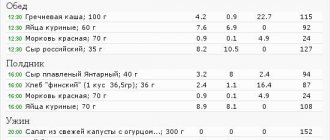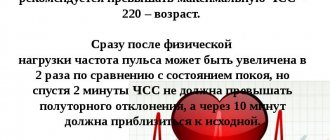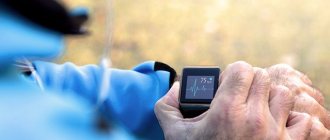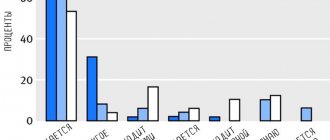Our body has two main sources of energy:
- Fat reserves.
- Glycogen.
Both are used to form adenosine triphosphate (ATP). ATP is the main energy substance. To produce adenosine triphosphate, our body either breaks down stored fat into fatty acids or uses glycogen stores to do so. The body strives to preserve the most valuable (from its point of view) source of energy, which is easily accessible and immediately ready for use. As you understand, we are talking about glycogen. In terms of availability and ease of use of energy sources, fat stores are in last place, and glycogen is at the very top. The body always keeps glycogen reserves ready to use at the right time. And he doesn’t spend it left and right, but saves it for a situation when he’s really needed. Therefore, when the body's activity is very low, such as during sleep, the body primarily uses fat reserves to produce ATP. During low-intensity physical activity, such as walking, the body will have to use up some glycogen, but will still be able to process fat quickly enough to meet the demand for ATP. When exercise becomes more intense, such as lifting weights or running at speed (sprinting), the body is forced to draw even deeper from its glycogen stores. That is, the intensity of the load determines which energy source will be used. There is such a popular concept as fat burning zone . This is the heart rate at which the body burns the maximum number of calories possible, but primarily relies on fat reserves as a source of energy. Things like jogging, cycling, rowing, swimming and others meet all these requirements. They burn a significant amount of calories, but at the same time the heart rate is still quite low, and therefore most of the energy comes from fat. In other words, the body has time to produce ATP from fatty acids to perform these exercises.
Why do you need cardio training?
The main goal of such training is to:
- the body has become stronger and more resilient;
- immunity strengthened;
- the person has become more resistant to stress;
- the body became athletic and lost weight;
- the cardiac system began to work better.
Today there are several types of cardio training. There are separate sets of strength exercises, as well as special programs for women who want to lose weight. In addition, such a load is very useful for beginners in sports, since it makes it possible to prepare the heart for the upcoming loads.
Subtleties of calculation and control
One of the main parameters is MHR. Based on this indicator, it is possible to judge what contraction frequency the heart is capable of producing in a short period of time. Maintaining a maximum heart rate for a long time is dangerous to health and physically exhausts the human body. To work to the limit, it is worth training endurance, but even experienced athletes one day come to the need to reduce the intensity of training.
Maximum heart rate is often calculated based on age. The formula is as follows:
- For women: 226 - age.
- For men: 220 - age.
This means that for a 50-year-old man, the MHR is “equal” to 170 beats per minute.
For fat burning, the most effective range is considered to be 60-70% of MHR
(as mentioned above). If you adhere to these indicators during training, the training effectiveness will be greatest. It has been proven that with such a pulse, 80-85% of fat is burned.
So, for a 50-year-old man, the upper and lower parameters will be as follows:
- lower threshold: 170*0.6=102 beats per minute;
- upper threshold: 170*0.7= 119 beats per minute.
A similar principle applies to calculating the upper and lower heart rates for women.
One more question remains - how to control the pulse? During the lesson, you should periodically touch your wrist and count your heartbeats. If the indicator is low, then you should become more active. If, on the contrary, the heart rate is too high, then it is worth reducing the pace of work. The disadvantage of the method is that when performing active exercises (jumping rope, for example), the pulse cannot be measured.
There is another way - buy a heart rate monitor, which is attached to your chest or arm and records your heart rate online. The advantage of such devices is that you can set the upper and lower limits. If it exceeds or decreases, the device gives a signal.
- The process of burning fat deposits occurs more actively when combining two training options - strength training and cardio. The advantage of the latter is strengthening the heart muscle, warming up the body, increasing blood circulation, developing the cardiovascular system, and accelerating fat burning processes.
- Application of dynamic loads. It has been proven that such loads involve the largest number of muscle groups. Thanks to such training, it is easier to burn calories, develop endurance, and strengthen the heart. Ideal options are cycling, running, swimming, aerobics, football and other activities.
- The duration of the aerobic activity is 30 minutes or more. This is enough to warm up the muscle corset, and then give maximum load. Here, “transport” cells come into play, transporting fats to the mitochondria with subsequent destruction of accumulations and release of useful energy. An important rule is to have a warm-up, which should take 5-10 minutes. At the end of the training process, breathing exercises or stretching are useful. The ideal time for training is 50-60 minutes (including warm-up).
- Many experts believe that to achieve a healing effect, you should visit the gym twice a week, but it is better to increase the number of trips to the gym to 3-4. Experienced athletes train more often - 5-6 times a week. But the main thing in training is not its presence, but its systematicity.
- The intensity of the load is controlled by heart rate.
To lose weight and lose weight, you need to exercise regularly. To effectively burn fat, you need to calculate the heart rate at which the workout will be as intense as possible. It is worth understanding that the result of the classes depends on this. For example, a high level indicates cardio exercises intended for weight loss, and a low rate indicates the development of endurance and body strength. It is important to understand that practicing without knowing the basics and maintaining them is a waste of time. You can exhaust yourself with training, exercise for two or three hours a day, and the weight will not go down. In order to avoid this situation, we recommend that you familiarize yourself with how to calculate your heart rate for burning fat.
Cardio for burning fat
The use of cardio training for the purpose of losing excess weight is a very popular trend in fitness, especially for middle-aged women. Treadmills are used in gyms for this purpose. With the right approach to exercise, these exercises effectively help in the fight against excess fat deposits. This effectiveness of the method is explained by the fact that under large and intense loads, lipids quickly oxidize and turn into energy, due to which a person can endure fairly heavy loads for a long time. Even experienced athletes recommend aerobic training for beginners.
You should also know that when performed correctly, cardio training is an excellent preventive measure for preventing the occurrence of vascular and heart diseases, which usually affect people from middle age. Those people who regularly train using this method are more resilient. This in turn increases their longevity and improves their health.
Training fat metabolism
If you read training literature such as “Heart rate, lactate and endurance training” by Peter Jansen, you will find references to “Extensive aerobic training”. It is characterized by two key points:
- Heart rate 70-80% of heart ratemax (or 82-89% of Friel’s anaerobic threshold heart rate).
- Long continuous operation . 1-3 hours of running (30 kilometers) or 100-200 kilometers on a road bike (2-6 hours).
Target heart rate zones for “fat burning”
What do we get for this?
- Due to this intensity, we oxidize fats as much as possible. We train “fat metabolism” and actively utilize them.
- We save carbohydrates and maintain the pace longer.
You can read more about how calories are consumed in our body and how to maintain a calorie balance during training here: Heart rate zone for fat burning - debunking myths
Well, in order to “burn excess fat”, we count calories, for example in MyFitnessPal (it works, tested by me), and we count energy consumption using a heart rate monitor and a fitness tracker. And we spend more energy than we consumed. That's the whole “secret”.
Frequency and timing of cardio training
In this type of physical activity, the load falls on most of the muscles and internal organs. During such training, the heart rate greatly accelerates. During exercise, the athlete inhales large quantities of oxygen, which takes part in the combustion of carbohydrates and fats, which leads to rapid weight loss.
Regular exercise can normalize blood pressure, speed up the digestion process and improve overall health. They also have a beneficial effect on a person’s morale and lift his spirits.
However, in order for aerobic training to be truly beneficial and effective, it must be done correctly. The most important conditions for aerobic exercise are the duration and frequency of its implementation.
The total duration of the entire workout should be thirty minutes. After the body gets used to the new loads, the training time can be increased to one hour. However, not all people have the opportunity to devote an entire hour to studying every day. In this case, trainers advise combining these exercises with normal daily activities. For example, instead of going to work or to the supermarket by car, you can get there by bicycle, or instead of taking the elevator, you can walk up the steps to your apartment.
Training frequency refers to the total number of sessions performed per week. The most effective way is to do four to five workouts every seven days. For those who are just starting to play sports, three classes a week will be enough. At the same time, breaks between trainings at first should be no more than two days.
The most favorable time of day for these activities is considered to be the evening, namely the period from five to seven in the evening. This is justified by the fact that the processes of metabolism and fat burning work best at this time. In the case when you do not have a goal for losing weight, but you need cardio training to increase overall endurance, then you can do it in the morning. However, it should be remembered that in the morning the metabolism is lower, so you should not overdo it with exercise.
Types of training: aerobic and anaerobic exercise
During aerobic training, muscles produce energy using oxidative (aerobic) processes. The initial phase of aerobic exercise burns glycogen stored in the muscles, after which energy is produced by burning fat. In this case, the duration of the exercise is extremely important, since fat burning occurs only after glycogen consumption , which lasts about the first 20 minutes of the workout. Aerobic exercise should last at least half an hour if your goal is to burn excess subcutaneous fat. If we are talking about cardio training, then the best option would be long-distance jogging.
Topic: cardio training - how to train the heart and blood vessels
During anaerobic training, muscles produce energy without using oxygen - the load on certain muscle groups is so great that the blood simply does not have time to deliver it to the cells. Anaerobic exercises by themselves do not reduce body fat, but their effectiveness in the process of losing weight cannot be denied - interval cardio helps build muscle mass, and the body continues to burn calories for several hours after an intense workout.
What should the pulse be?
During these workouts, heart rate is the very first indicator of a person’s activity. As a rule, novice athletes do not take into account the state of the body and exceed the permissible loads, expecting to immediately achieve good results. In fact, this is a very wrong and unreasonable approach that can pose a real threat to health.
Both experienced athletes and beginners during cardio training need constant monitoring of the heart rate, that is, its rhythm. In other words, even when performing exercises, a training person must look at his heart rate from time to time, and based on them, select the load for himself.
Also, before starting training, it is important to know your heart rate limits: the lower and upper limits. As for the workouts themselves, you should always take a heart rate monitor with you so that you can independently determine your heart rate.
How to Assess Cardio Intensity
A heart rate monitor that will accurately show your heart rate intensity will be an excellent assistant for cardio training. But if such a device is not available, then the degree of cardio load can be assessed based on your own sensations. The following indicators will help in this process:
- very light load: conversation goes without problems;
- light load: during a conversation you have to make minimal effort;
- medium light: slight tension is noted;
- moderate load: talking becomes increasingly difficult;
- medium moderation: effort is required to maintain a conversation;
- moderate-high: pronouncing words becomes difficult;
- high: it is possible to talk, but with great difficulty;
- intense: conversation becomes impossible.
In addition to these signs, you can also use an express test to calculate your pulse: you need to count the number of heart beats for 6 seconds and multiply the result by 10. But it is still optimal to use a heart rate monitor.
Heartbeat zones during sports
The boundaries of safe heartbeat zones are calculated depending on age. It is not necessary to remember all the numbers, the main thing is to remember your personal maximum and train within 65-75% of it.
- Pulse at rest - 35-50%
- Warm-up zone - 50-60%
- Activity zone - 60-70%
- Aerobic zone - 70-80%
- Endurance zone - 80-90%
- Danger zone - 90-100%
How to calculate your maximum heart rate: 220 - age = maximum heart rate.
Dangerous heart rate when running
The heart rate for safe cardio is 115-150 beats per minute - going to higher numbers is allowed, but for one or two minutes (as in the case of fat-burning HIIT workouts).
Being in the zone of 90-95% of maximum heart rate is dangerous. If you reach these numbers, take a break. Also note that at the age of 30, the normal resting heart rate is 60-80 beats per minute - if your heart rate is above this value, then you most likely have elevated levels of the hormone cortisol. Let us remember that this hormone is responsible for the gain of fat in the abdominal area.
How to get rid of fat in the lower abdomen and remove soft sides? The best training strategy and cutting recommendations.
Fat burning heart rate zone
When running in the “fat burning zone” of 60-70%, the body covers the largest percentage of energy costs from fat deposits. In 30 minutes of such training, 146 calories are burned, 73 calories (50%) of which are fat.
When training at a higher or lower heart rate, the body works differently, covering no more than 35-40% of energy costs from fat. However, it is important to note that the duration of training at a low heart rate may be higher, as well as the total number of calories burned.
Running for weight loss in the morning
In order to burn more fat when running, you need to think not only about your heart rate, but also about where your body will get its energy from.
If you eat a large, simple carbohydrate lunch 1-2 hours before your workout, most of your energy will come from that food rather than from fat. To maximize fat burning, it is recommended to exercise either in the morning on an empty stomach or 3-4 hours after eating. Even though in this case you will reach an average heart rate, and the workout will be less intense, however, the body will really need to use its reserves.
Running and other cardio in the 60-70% MHR zone (about 115-135 beats per minute for age 30) forces the body to use the maximum proportion of fat to fuel its work. However, remember that the duration of the training and the presence of food in the stomach plays a more important role in burning fat.
Karvonen Formula for Women
Developed by Karvonen, the formula “220 is the age of a person” is the most common method for measuring maximum heart rate. For women it looks like this: (220-age-resting heart rate)*resting heart rate intensity factor. Calculate your resting heart rate in the morning, before getting up, and the intensity factor is 70% of the MHR.
For a thirty-year-old woman with a resting heart rate of 70 beats per minute, the formula that will show at what heart rate burns fat in women will look like this: (220-30-70)*0.3 70 = 121 beats/min. Just remember that the formula was calculated for professional athletes; you can skip the step of multiplying by the intensity factor first. For this woman, the correct heart rate for burning fat is between 120 beats/min.
How to create a fat burning program
All information is luxuriously laid out on shelves and in places! There is no cheap populism, there is a clear focus on long-term work to create a fat-burning program.
We invite you to familiarize yourself with Target Heart Rate for Fat Burning
After a workout, it is best to have a good sleep, not household activity. During sleep, recovery occurs, minor injuries heal and muscle mass increases. If after training you also engage in other activities, then chronic lack of sleep and deterioration of the immune system are guaranteed. But naturally, I mean a workout during which it is impossible to talk on the phone or communicate with people, and after it the muscles are simply killed.
I admit that if such a workout took place during the day or in the morning, then it is best to first take a nap during the day, and then go for a walk or do business. Yes, and after training, not everyone eats a piece of cake right away, there aren’t that many stupid people. Many smart people eat cottage cheese and go to bed.
Let's summarize: The most effective means for losing weight has always been rational cardio training, which in a few months relieves a person of excess weight, shortness of breath and metabolic problems. Those who want to lose weight should know at what heart rate fat is burned. When starting classes, you should calculate your individual heart rate threshold using the Karvonen formula.
Regular running training and knowledge of your own body will definitely bear fruit for those who want to become vigorous and strong.











